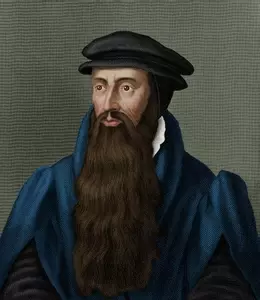John Knox - Scotland's great Reformer
[For the background to this series of articles see the post for May 2022, Forty years ago]
John Knox
Scotland’s great Reformer
When John Knox arrived in the east coast town of St Andrews in June 1559 his friends were anxious to prevent him preaching. The reason? A threat from the archbishop that if he appeared in the pulpit the soldiers present would shoot him. But Knox was resolute. ‘As for the fear of danger that may come to me, let no man be solicitous; for my life is in the custody of Him whose glory I seek.’ So the following day he preached. And no one in the vast crowd who listened gave him a moment’s trouble.
Called to preach
There were particular reasons why Knox was so keen to preach in St Andrews. For one thing, it was in St Andrews that God had first called him, in his own words, ‘to the dignity of a preacher.’ The year was 1547 and Knox was a marked man. He had abandoned the Roman Catholic priesthood, had openly identified with those seeking the reformation of the church, and was having to move from place to place for his own safety. Finally, along with others, he took refuge in the castle of St Andrews.
It quickly became evident that Knox was a man of considerable ability. His lessons on John’s Gospel for the boys he was tutoring were given publicly and lots of the townspeople came to listen. But though urged to, he was reluctant to take the further step of becoming one of the preachers to the castle garrison. He ‘would not run’, he said, ‘where God had not called him.’ Recourse was had, therefore, to a stronger measure.
One day, in the presence of the castle congregation Knox was put on the spot. It had all been pre-arranged. John Rough, who was eager to have Knox as a colleague, was speaking about the authority of a congregation to call someone who had the requisite preaching gifts and on the peril of refusing such a call. Turning to Knox he then charged him, in the name of God and of the congregation, not to refuse. ‘As ye tender the glory of God, the increase of Christ’s kingdom, the edification of your brethren, and the comfort of me, oppressed by the multitude of labours…take upon you the public office of preaching, even as ye look to avoid God’s heavy displeasure, and desire that he shall multiply his graces upon you.’ The congregation then voiced their approval. The experience was so overwhelming for Knox that he burst into tears and shut himself up in his room for several days. But it set the course for the rest of his life. From that time on his chief work was preaching.
A prisoner
There was a second reason why in June 1559 Knox was so anxious to preach in St Andrews. Long before, in circumstances that made such an event seem highly improbable, he had openly said that he would. Knox’s time in the castle ended with a siege, a surrender, and nineteen months chained to the oar of a French galley. Conditions were dreadful. Knox’s health was permanently impaired and at one point he was so ill that it was feared he would die. He himself, however, was sure that he would both live and be released. On an occasion when the galley was lying off St Andrews a fellow prisoner raised him up and asked him if he knew the place. ‘Yes’, was the reply, ‘I know it well. I see the steeple of that place where God first in public opened my mouth to His glory, and I am fully persuaded, how weak soever I now appear, I shall not depart this life till my tongue shall glorify His Holy Name in the same place.’
When that expectation was fulfilled in June 1559 Knox had only been in Scotland for a month. Most of the previous ten years had been spent elsewhere. From the end of his captivity in 1549 till after the death of King Edward VI the scene of his ministry was England, particularly Berwick and Newcastle. He also served as one of King Edward’s chaplains. It was during his time in England that he met his first wife, Marjory Bowes.
Everything changed with the death of King Edward in 1553 and the accession to the throne of Edward’s sister Mary. Edward was a devout Protestant, thoroughly in sympathy with the Reformation. Mary, by contrast, was a fanatical Roman Catholic, and under her reign many Protestants suffered martyrdom. Others, for their safety, went into exile on the European continent. Knox was among them. There he had a brief ministry in Frankfurt, which ended very unhappily, and then a longer and much happier ministry in Geneva to a congregation of English exiles.
Back to Scotland
All through these years Knox’s heart was in Scotland. He was burdened for its reformation and longed to be back. He did in fact spend a hugely encouraging few months there in early 1556. Writing to his mother-in-law, Elizabeth Bowes, he could say, ‘If I had not seen it with my eye in my own country, I could not have believed it…The fervency here doth far exceed all others that I have seen…’ And again, ‘Rejoice, Mother, the time of our deliverance approacheth; for as Satan rageth, so does the grace of the Holy Spirit abound, and daily giveth new testimonies of the everlasting love of our merciful Father.’
Three further years, however, were to elapse before Knox could return to Scotland permanently. But when he did the pace of the Reformation was swift. Just a few days before his June 1559 visit to St Andrews the nobles who were spearheading the movement for reform – they were known as the Lords of the Congregation – solemnly committed themselves to abolishing Catholicism and establishing Protestant worship in all the places where they had authority. Their starting place? St Andrews! Knox preached there on five successive days and with such power that the majority of the people and not a few of the clergy renounced their allegiance to Rome. The longed-for victory came the following year, 1560. In August the Scottish Parliament brought the authority of the Pope to an end, prohibited the celebration of the mass, and approved a Confession of Faith drawn up by Knox and other ministers.
Knox himself became the minister of the congregation that met in Edinburgh’s St Giles Cathedral. His preaching there, as it had been from the beginning, was marked by plainness of speech and great courage. He once declared that, ‘From Isaiah, Jeremiah, and other inspired writers, he had learned to call a fig a fig, and a spade a spade.’ Again, in one of his interviews with Mary Queen of Scots he could say, ‘Without [outside] the preaching place, Madam, I think few have occasion to be offended at me. There, Madam, I am not master of myself, but must obey Him who commands me to speak plain, and to flatter no flesh upon the face of the earth.’ His biographer, Thomas M’Crie, speaks of his ‘bold, fervid, and impetuous eloquence’, and how it was ‘singularly adapted to arrest the attention and govern the passions of a fierce and unpolished people.’ But Knox could also speak (and write) with great tenderness. He had suffered greatly in the course of his life and the strong consolations he had enjoyed himself he was able to pour into the hearts of others.
Final years
Twelve years remained to Knox but they were far from easy or peaceful. At the end of 1560 he had the sorrow of losing his wife, Marjory. The arrival, too, of Mary Queen of Scots, the brief but turbulent years of her reign, the civil war that followed, the assassination of the Regent Moray, the defection to the Queen’s party of some of the nobles and the greed of many of the others, cast a dark shadow over the church and the nation. Knox was himself in danger. From May 1571 till within a few months of his death it was necessary for him, for his safety, to leave Edinburgh and live, once again, in St Andrews.
There he continued to preach. James Melville, then a student, later a minister in the not-so-distant village of Anstruther, records in his diary how Knox was so feeble that it needed two men to help him into the pulpit. But the old fire and energy would return. ‘In the opening up of his text’ writes Melville, ‘he was moderate the space of an half hour; but when he entered to application, he made me so to grew [thrill] and tremble, that I could not hold a pen to write.’ And though so weak that at first he had to lean on the pulpit, ‘ere he had done with his sermon, he was so active and vigorous, that he was like to ding the pulpit in blads [beat it in pieces], and fly out of it.’
Returning to Edinburgh, Knox preached for the last time on Sunday 9th of November 1572. It was his joy on that occasion to preside at the installation of James Lawson as his colleague and successor. He concluded the service with a fervent prayer for God’s blessing on both minister and congregation. Then, writes M’Crie, ‘leaning upon his staff and the arm of an attendant, [he] crept down the street, which was lined with the audience, who, as if anxious to take the last sight of their beloved pastor, followed him until he entered the house, from which he never came out again alive.’
On the afternoon of his last day, 24th November, he asked his wife Margaret, whom he had married in 1564, to read to him the fifteenth chapter of 1st Corinthians. ‘Is that not a comfortable chapter?’ he asked. Later he requested that she read the seventeenth chapter of John’s Gospel, ‘where’, he said, ‘I first cast my anchor’. As the day drew to a close he gave a deep sigh, and whispered, ‘Now it is come’. Moments later, in his biographer’s words, he ‘rendered up his spirit, apparently without pain or movement, so that he seemed rather to fall asleep than to die.’
John Knox was hated in his day and he is hated still. And no-one would deny that he had his faults. But by those who love his gospel, who appreciate how remarkably God used him in bringing reformation to Scotland, and who are in thorough sympathy with the fruits of his labours in church and national life, he will ever be regarded as among the greatest of Scotsmen.


